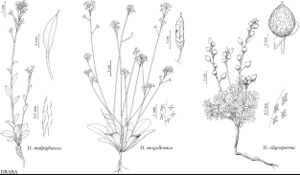Draba oligosperma
Fl. Bor.-Amer. 1: 51. 1830.
Perennials; (cespitose, densely pulvinate); caudex branched (with persistent leaf-bases, branches congested or somewhat creeping, sometimes terminating in sterile rosettes); scapose. Stems unbranched, (0.1–) 0.2–0.6 (–1) dm, glabrous throughout or pubescent, trichomes sessile, pectinate, 0.1–0.3 mm, (their length parallel to long axis of stem). Basal leaves rosulate; sessile; blade linear to linear-oblanceolate, (0.2–) 0.4–1.1 (–1.5) cm × 0.4–1.5 (–1.8) mm, margins entire, (not or, rarely, ciliate, trichomes simple, 0.2–0.4 mm), surfaces pubescent with sessile, pectinate trichomes, 0.1–0.4 mm, (their long axis parallel to prominent abaxial midvein), sometimes glabrous adaxially. Cauline leaves 0. Racemes 4–12 (–17) -flowered, ebracteate, elongated in fruit; rachis not flexuous, glabrous or pubescent as stem. Fruiting pedicels divaricate-ascending, straight, (2–) 3–10 (–13) mm, glabrous or sparsely pubescent, trichomes pectinate. Flowers: sepals ovate, 1.5–3 mm, glabrous or sparsely pubescent, (trichomes pectinate, 2-rayed, or simple); petals usually yellow, rarely creamy white, obovate, 2.5–4 × 1.5–3 mm; anthers ovate, 0.4–0.5 mm, (not producing pollen). Fruits ovoid to lanceolate, plane, inflated at least basally, sometimes slightly flattened distally, 3–6 (–7) × 2–3.5 (–4) mm; valves usually puberulent, rarely glabrous, trichomes simple and sessile, often unequally 2-rayed, 0.07–0.35 mm; ovules 6–12 per ovary; style 0.1–0.8 (–1.1) mm. Seeds ovoid, 1.1–1.5 × 0.7–1 mm. 2n = 32, 64.
Phenology: Flowering May–Jul.
Habitat: Rock outcrops, talus, gravel benches, tundra
Elevation: 200-3900 m
Distribution

Alta., B.C., N.W.T., Nunavut, Yukon, Alaska, Calif., Colo., Idaho, Mont., Nev., Oreg., Wyo.
Discussion
Draba oligosperma is a highly variable and widespread species that has been shown to be apomictic (G. A. Mulligan and J. N. Findlay 1970; Mulligan 1972). It has been divided into species and infraspecific taxa by previous authors; the variation is continuous in every character; there are no clear geographical and morphological patterns that support its division. For characteristics separating D. oligosperma from the closely related D. pectinipila, see 80. D. pectinipila.
Draba andina (Nuttall) A. Nelson (1899), not Philippi (1858) is an illegitimate name, sometimes found in synonymy under D. oligosperma.
Selected References
None.
Lower Taxa
"elongated" is not a number."thick" is not a number."dm" is not declared as a valid unit of measurement for this property."dm" is not declared as a valid unit of measurement for this property.
